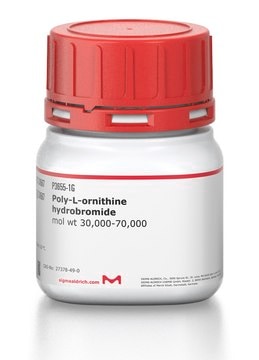P4957
Poly-ʟ-Ornithine
synthetic, mol wt 30,000-70,000, liquid, 0.01%, suitable for cell culture
About This Item
Produits recommandés
product name
Poly-L-ornithine solution, mol wt 30,000-70,000, 0.01%, sterile-filtered, BioReagent, suitable for cell culture
Source biologique
synthetic
Niveau de qualité
Stérilité
sterile-filtered
Gamme de produits
BioReagent
Forme
solution
Poids mol.
30,000-70,000
Conditionnement
pkg of 50 mL
Concentration
0.01%
Technique(s)
cell culture | mammalian: suitable
Couverture de surface
4 μg/cm2
Impuretés
endotoxin, tested
Conditions d'expédition
ambient
Température de stockage
2-8°C
Chaîne SMILES
Br.NCCCC(N)C(O)=O
InChI
1S/C5H12N2O2.BrH/c6-3-1-2-4(7)5(8)9;/h4H,1-3,6-7H2,(H,8,9);1H
Clé InChI
GWRQMKDBBHFVIZ-UHFFFAOYSA-N
Description générale
Application
Actions biochimiques/physiologiques
Notes préparatoires
Produit(s) apparenté(s)
Code de la classe de stockage
10 - Combustible liquids
Classe de danger pour l'eau (WGK)
WGK 3
Point d'éclair (°F)
Not applicable
Point d'éclair (°C)
Not applicable
Certificats d'analyse (COA)
Recherchez un Certificats d'analyse (COA) en saisissant le numéro de lot du produit. Les numéros de lot figurent sur l'étiquette du produit après les mots "Lot" ou "Batch".
Déjà en possession de ce produit ?
Retrouvez la documentation relative aux produits que vous avez récemment achetés dans la Bibliothèque de documents.
Les clients ont également consulté
Articles
Poly-Lysine enhances electrostatic interaction between negatively-charged ions of the cell membrane and positively-charged surface ions of attachment factors on the culture surface. When adsorbed to the culture surface, it increases the number of positively-charged sites available for cell binding.
Frequently asked questions about neural stem cells including NSC derivation, expansion and differentiation.
Derivation and characterization of functional human neural stem cell derived oligodendrocyte progenitor cells (OPCs) that efficiently myelinate primary neurons in culture.
3D cell culture overview. Learn about 2D vs 3D cell culture, advantages of 3D cell culture, and techniques available to develop 3D cell models
Protocoles
A stem cell culture protocol to generate 3D NSC models of Alzheimer’s disease using ReNcell human neural stem cell lines.
Step-by-step culture protocols for neural stem cell culture including NSC isolation, expansion, differentiation and characterization.
Notre équipe de scientifiques dispose d'une expérience dans tous les secteurs de la recherche, notamment en sciences de la vie, science des matériaux, synthèse chimique, chromatographie, analyse et dans de nombreux autres domaines..
Contacter notre Service technique











